Dear Reader, in this age of AI created content, please support with your goodwill someone who works harder to provide the human-made. Sign up at the top of the lefthand column or bottom of this page. You will receive my hand illustrated monthly newsletter RESTORE NATURE and access to the biodiversity garden design course as I write...and nothing else, I respect your time. I am also removing the advertizing as best I can as its become intrusive inappropriate and pays me nothing.
Hot weather vegetables in a Mediterranean type climate
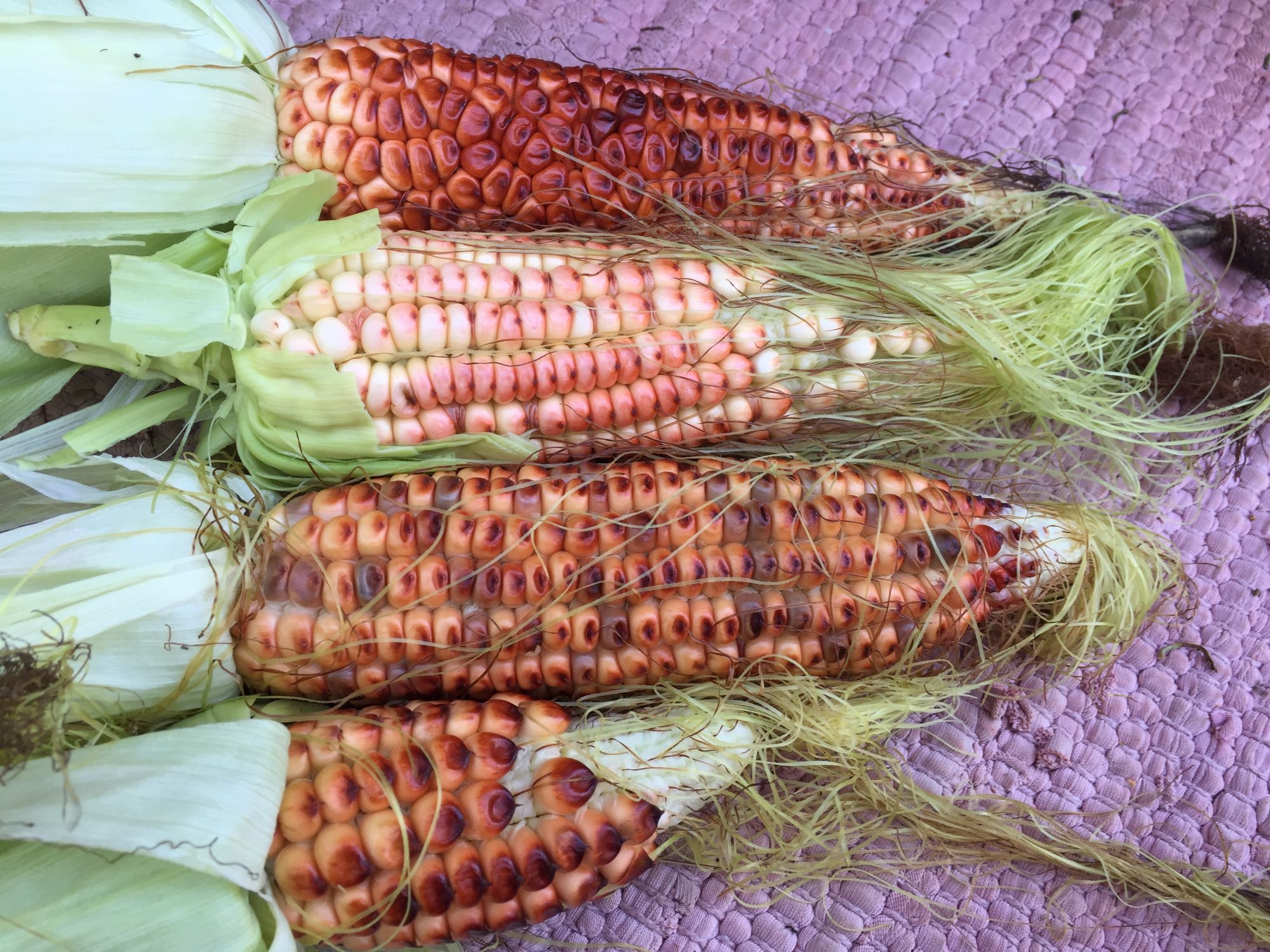 Learning my hot weather vegetables: red glass maize picked too early to be red, too late for tenderness ?
Learning my hot weather vegetables: red glass maize picked too early to be red, too late for tenderness ?This article is a review of my successes and failures with growing hot weather vegetables this year and the effects of our particular climate. Growing food is often thought to conflict with protecting biodiversity. Many people in the world are malnourished or undernourished, and food insecurity is a reality in many places. Growing food effectively is an urgent human need, and I’m sure we can do this without degrading our soils, water cycles and ecosystems, because without them we probably will not survive. Producing food does not have to conflict with protecting biodiversity and to prove this to our communities in Cape Town, I have to increase the biodiversity in my garden while still being good at growing food. Growing native perennial food plants clearly doesn't get this message across, as people struggle to see the produce as good food, although in many ways it is far superior to the European style annual vegetables.
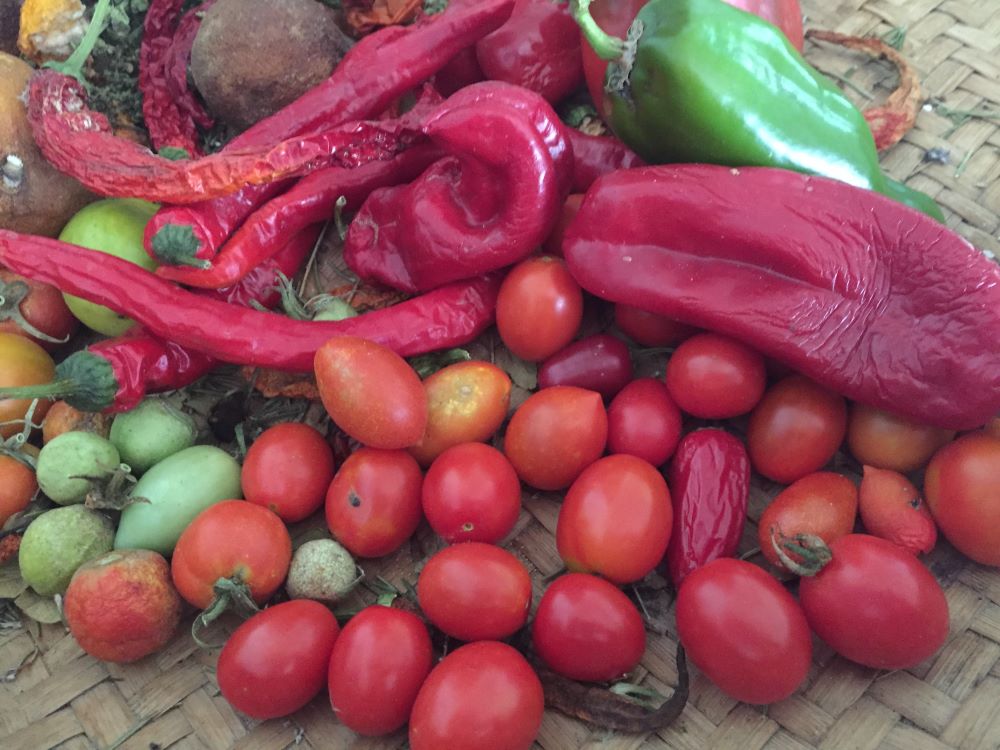 Hot weather vegetables give fiery colour to a fiery season.
Hot weather vegetables give fiery colour to a fiery season.My sincerest admiration for vegetable growing masters
I decided to get serious about growing vegetables last spring and therefore started with the hot weather vegetables. What I show here may be imperfect, but in the years before this it was spotty indeed. I completely gave up on annual vegetables for a very long time, while I planted native and non native perennial berry bearing trees and herbs.
Coming back to annual vegetables, there is so much to learn and it was time to start on a more thorough and deep learning journey. Getting it right involves high levels of skill which are played down by popular memes, which may leave you thinking growing your own food just comes naturally and mostly works out just fine. All mankind once grew or foraged their own food, its true, but I’m always and still astonished at the level of practical knowledge, agile memory, and ruthless problem solving our ancestors might have possessed, and any successful backyard vegetable grower certainly has.
I’ve been working with growing food for decades, and have a luxuriant food forest, but never really got the hang of growing classic annual vegetables like potatoes and carrots. For me, growing annual vegetables is one of the most difficult forms of horticulture.
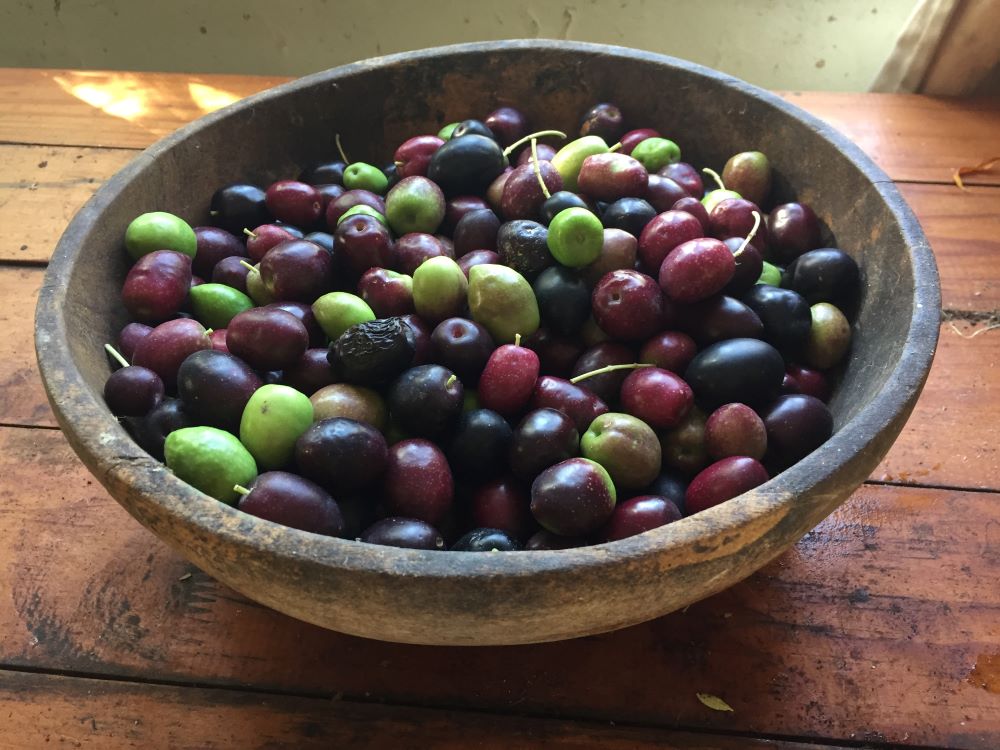 Perennial berry trees are relatively low maintenance, but they too will indicate neglect, as our olive harvest shows. Our record was 40 liters per tree when they were surrounded by worm beds. I'm building organic matter around the trees again.
Perennial berry trees are relatively low maintenance, but they too will indicate neglect, as our olive harvest shows. Our record was 40 liters per tree when they were surrounded by worm beds. I'm building organic matter around the trees again.Frustration leading to simplification:
the sowing roster
After struggling for years with the complex sowing rosters required by seed catalogues and sowing calendars, and being an apprentice to a famous local gardener who interplanted on a weekly basis, I created a spreadsheet of the planting and growing times of most classic vegetables in our climate. I checked up on the ideal sowing dates. Online information is a mess of contradictions, in addition to being northern centric, just because of the number of internet users in the north. Using the overlaps in the ideal sowing times, I sought to cut down on their number. Eventually I decided to sow vegetables twice a year only, dividing everything into summer and winter vegetables. It not only cuts down on labor but on the enormous cognitive load and complexity of planning created by the diverse needs of annual vegetables. I realize this will not work in all climates, and for other people lengthening the growing season by starting indoors under lights and other such techniques are the biggest concern.
One must make the best of the resources one actually has, and one of them is time. Weekly sowing is just not on the cards when illustrating books on agroforestry and doing other projects actually brings me a living.
Summer and winter crops divide themselves in our fortunate region, into hot weather vegetables grown in the summer drought, and winter vegetables growing in sometimes unremitting winter rain. Our winter probably more closely resembles English growing conditions in summer, but seeds have calculations all their own, based on day length and other occulted signals we are not conscious of, so all vegetables will not bend to the roster.
So far my twice a year system is functioning. I can manage the sowing and planting out between other work and the seeds I’ve sown have all germinated (except for the butter lettuce), and about 70% of the summer plants survived, though they were sown very late in October, and planted out in November and December.
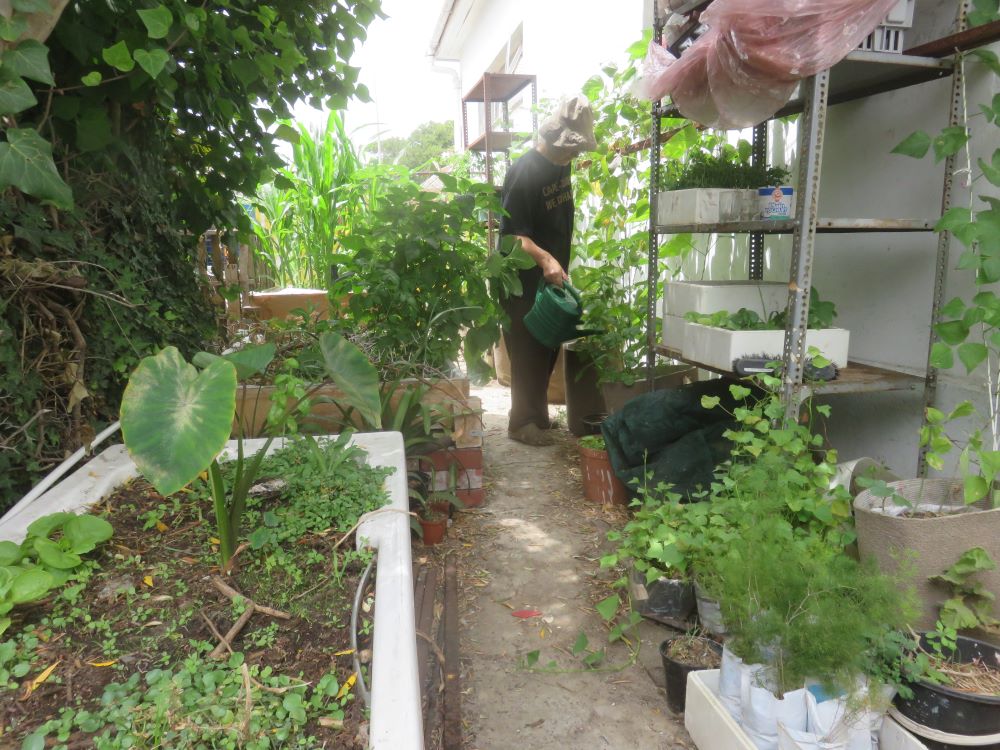 The concrete driveway where I grow my hot weather vegetables in containers and raised beds and sow out plants in trays in the vertical plastic covered 'greenhouse' on the right.
The concrete driveway where I grow my hot weather vegetables in containers and raised beds and sow out plants in trays in the vertical plastic covered 'greenhouse' on the right.Which hot weather vegetables did I propagate, and what germinated ?
I sowed 9 trays of summer vegetables and other seeds which were old and I just wanted to get rid of. This is just because 9 trays fit perfectly in my vertical greenhouse, made of a on old metal shelf curtained with transparent plastic that is held in place with wire hooks and twine. I buy reject polystyrene trays from a factory. They are just the size manageable for me if filled with soil, and super light if filled with plastic six packs.
In the beds I planted lots of garlic cloves and some turmeric, and about 15 potatoes. I started about ten taro roots in pots in the dark, and in jars of water I grew about 5 sweet potato tubers and planted them out in pots and in the raised beds. In one planter I just used sweet potato cuttings to try it out for the first time.
The seeds that came up were some kale, maize, beans, okra, amaranth, chard and beetroot, Malabar spinach, lettuce, parsley, dill and Cheyote squash. I used opportunistic tomatoes, my husband gave me tomato and basil seedlings in pots and raised his favorite capsicums alone.
 My kale plants at their best
My kale plants at their bestThe kale plants germinated but they were of a lanky type and spent most of the time hanging limply over the edge of the raised bed. We’ve had about 3 meals where they served as greens. In late summer they became infected with white fly and I was delighted ! Especially when I discovered a little batch of yellow eggs on the underside of one of the leaves. I've had so few pests and all these small creatures are food for other things higher up the food chain, and I want to increase biodiversity !
The queen of hot weather vegetables, maize.
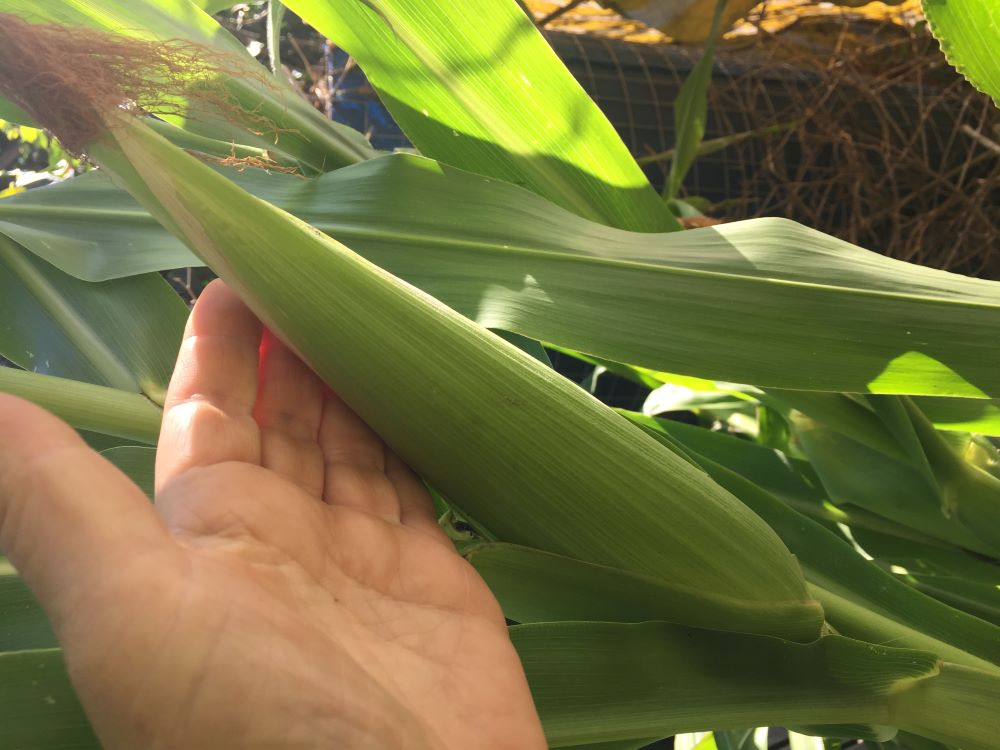 A sturdy maize cob despite the plants being flattened by wind and tied up with string !
A sturdy maize cob despite the plants being flattened by wind and tied up with string !The maize is still ripening. I sowed red glass maize seed bought from an online catalogue but it looks as if most of the cobs are going to come out yellow with maybe a touch of pink. I noticed about 2 out of the 20 plants had red parts, red roots, red beards and reddish anthers, while the rest were coloured pale green. I will see how the cobs on the red plants turn out. It looks like I will get about 12 decent sized cobs and lots of half formed small ones. I tried my best to insure pollination by planting them in a dense stand, and taking the anthers and dusting all the corn silk I could see, but the wind flattened them twice and the plants were just hanging on by a thread, literally. I tied them up with string to stop them from lying on the ground. I hope for a better harvest next year.
The bean alley
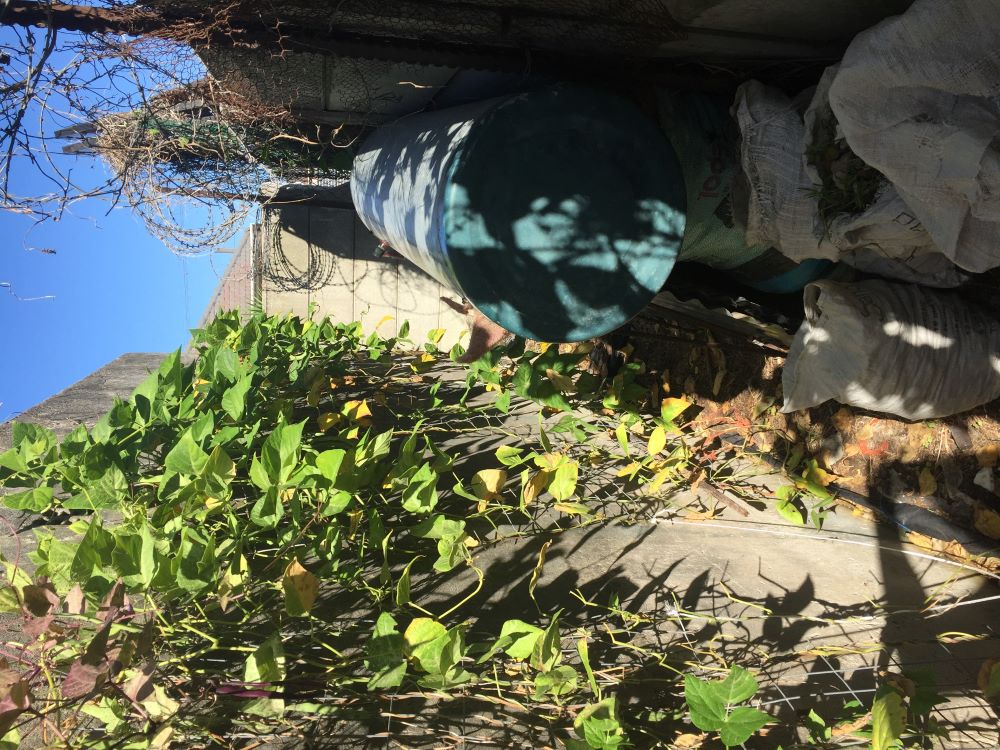 Making the most of a tiny urban space. This alley is behind the garage and I have to squeeze past the old solar geyser to water the beans.
Making the most of a tiny urban space. This alley is behind the garage and I have to squeeze past the old solar geyser to water the beans.The beans came well. I grew about 15 of them in the bean alley and in the drive way a further 35 plants went into 7 bags made with a rice sack surrounded by old beige carpeting to protect the rice sack from UV. They produced about 1 kg of beans over such a long time that there was never really enough for one good meal. I had rattlesnake, blue Peter and white runner beans, and they all bore well, the rattlesnake the earliest, overlapping with blue Peter, which continued until the white runner beans began to fruit. All in all the blue Peter fruited for the longest time. In the bean alley they were up against a rough plaster wall, with buried plastic from an old worm farm hemming them in. They formed the toughest stalks and the plants looked the healthiest but they don’t seem to be bearing at all, although the majority are the late bearing white runner beans so we’ll wait and see. To get a decent harvest I guess I will have to ramp up my beans plants from fifty to a hundred, and that is for just two people.
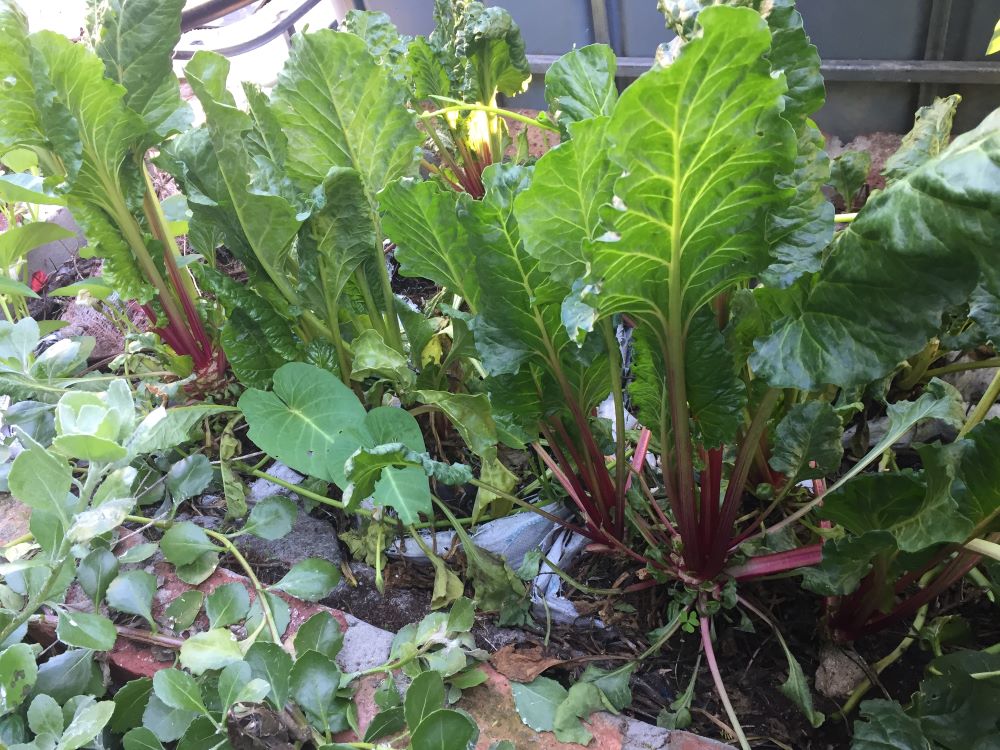 Chard flourishes in my grey water system.
Chard flourishes in my grey water system.Some prodigious leafy greens
Chard and beetroot showed up as usual. I often grow them in my serial grey water grow beds and they flourish there, producing giant meter high chard till the chard gets a sort of yeast infection which smells bad. I try to combat this by thinning them a lot. The beetroot bulbs were giant green misshapen things with only a trace of red. Perhaps it is too wet for highly colored roots to form.
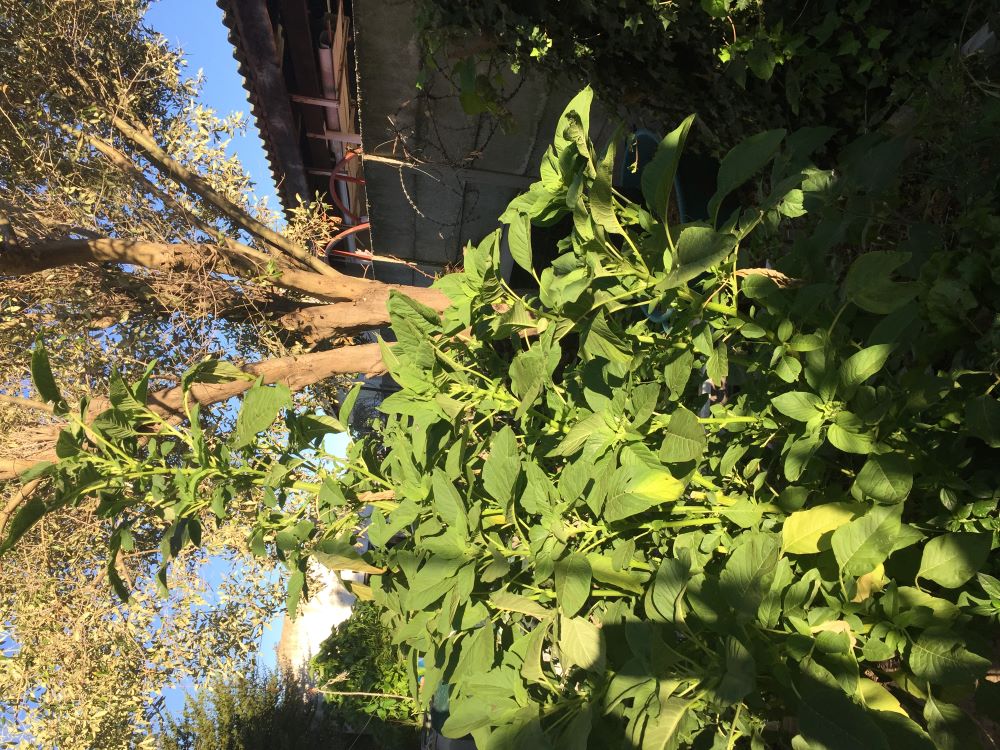 African amaranth forms a towering spike half as high as the olive tree, and much taller then my outstretched phone hand.
African amaranth forms a towering spike half as high as the olive tree, and much taller then my outstretched phone hand.The African amaranth is a people pleasing monster. It seems it will grow anywhere, from a pavement to a swamp garden, and is self seeding after just two seasons. It needs next to no water and grows into an enormous tall plant producing a lot of greens, more than we can eat ourselves.
Malabar spinach (Basella alba) loves my swamp garden and the grey water system but it doesn’t grow as tall as I’ve heard tales of (tall tales ?) Perhaps Basella rubra grows taller. Alba is succulent with leaves the size of plates, and branches maxing at about 2 meters. I could have had about 10 meals from this plant perhaps, but I’ve so many greens I didn’t exploit it enough. It dies off in winter so I keep seed. Another swampy plant we grow for greens in summer is Ipomea aquatica which I grew from some vegetables we bought at the Chinese food market. It gets enormous in our fish filters in summer, we just can’t eat it all and give a lot away, and compost the rest of the trimmings. Then it dies back in winter and comes again with the hot weather.
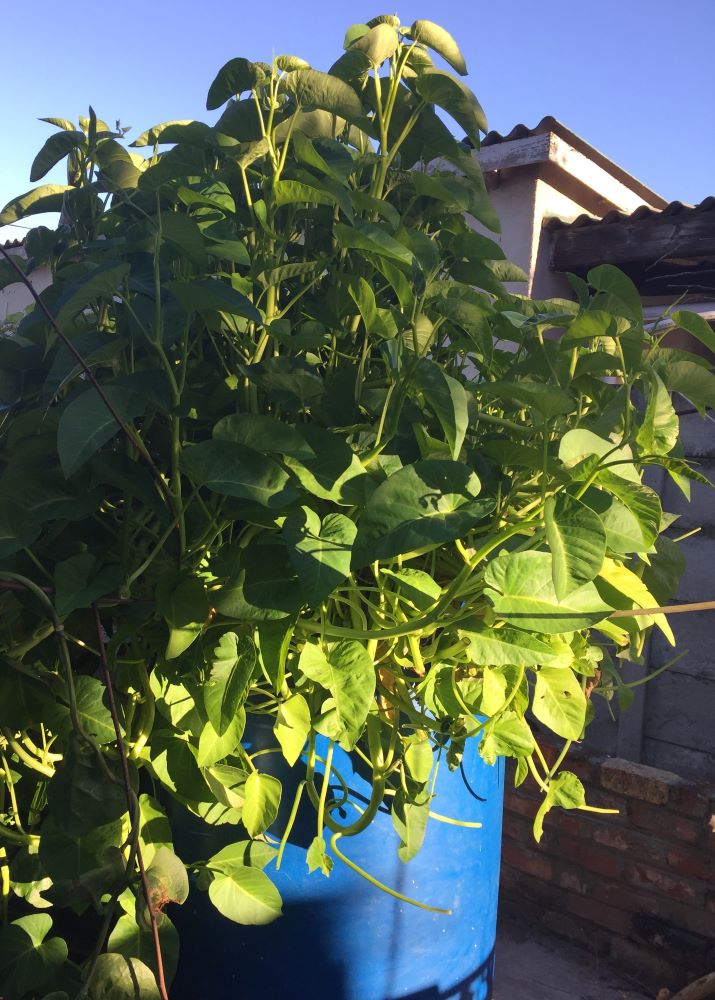 Ipomea aquatica in a fish pond filter. It has edible leaves and stalks. Related to morning glory and sweet potoatoes.
Ipomea aquatica in a fish pond filter. It has edible leaves and stalks. Related to morning glory and sweet potoatoes.Cheyote squash are easy to germinate if you can get hold of the fruit, which has one giant seed in it. What a marvel. I grew several cheyote squash vines from fruit I bought at the Chinese food store, picking ones which were not green but more whitish and had already started to split. I gave some away, planted four, two died. I think they like a lot of water, because the two that died were planted in a place that is too well drained and I don’t get to often to water. The other two vines appear to be healthy with branches several meters long. As the winter rains came they took off, and look better than ever before. One is growing on the barbed wire at the top of the 2 meter vibracrete fence, the other is trailing over a wood pile. I had given up on growing cucurbits as I seem to have fungus everywhere in my garden. These are far away from where I’ve grown other cucurbits, with a concrete driveway between them and the rest of the garden, but they may succumb and I’m not getting attached, like I was to the Gemsbok cucumber native to our continent that flourished and then died suddenly in a couple of days.
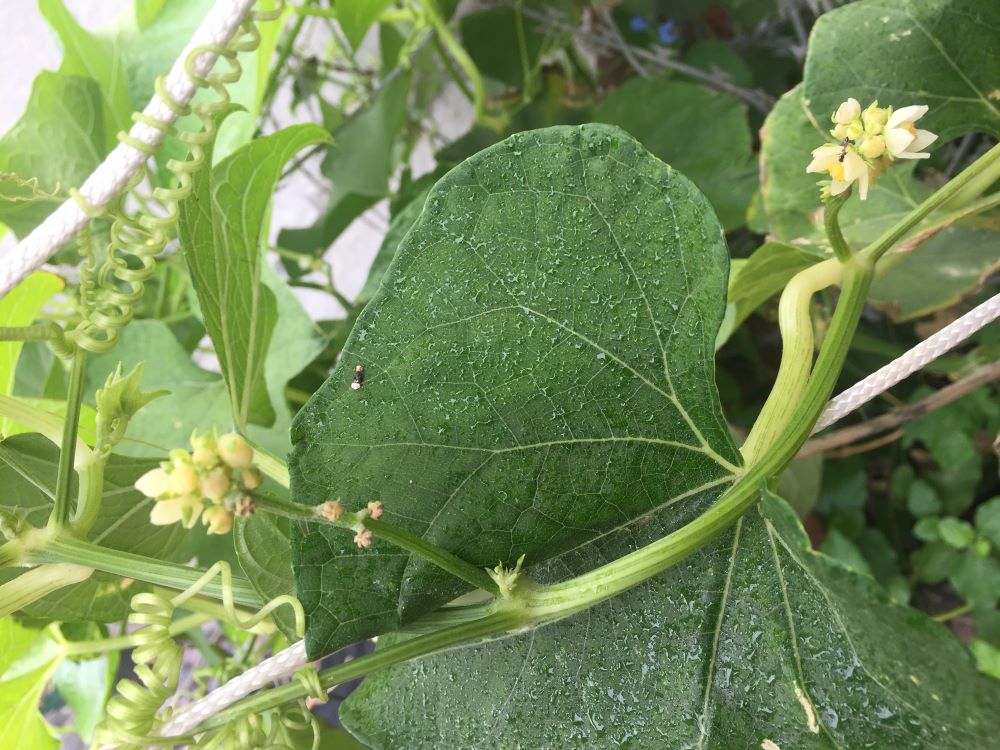 The Cheyote squash vine surprised me with the tiny size of its flowers.
The Cheyote squash vine surprised me with the tiny size of its flowers.My opportunistic tomato had large very tasty fruit and bore well but was over in a month or so. The other cherries my husband gave me I grew in an iron shelf, in a box, for them to trail down. I saw trailing tomatoes in a video. The stems look funny. I don’t think trailing really suits them. They have born semi ok for cherries. Not great.
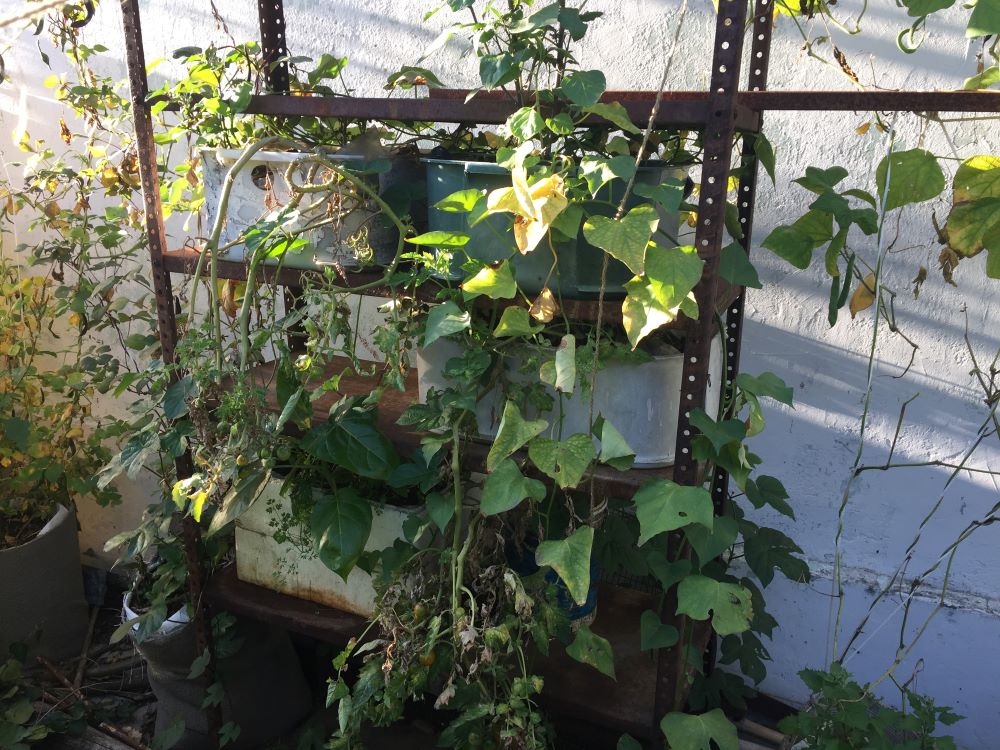 Tomatoes and sweet potato vine trailing from a shelf
Tomatoes and sweet potato vine trailing from a shelfThe struggle with roots
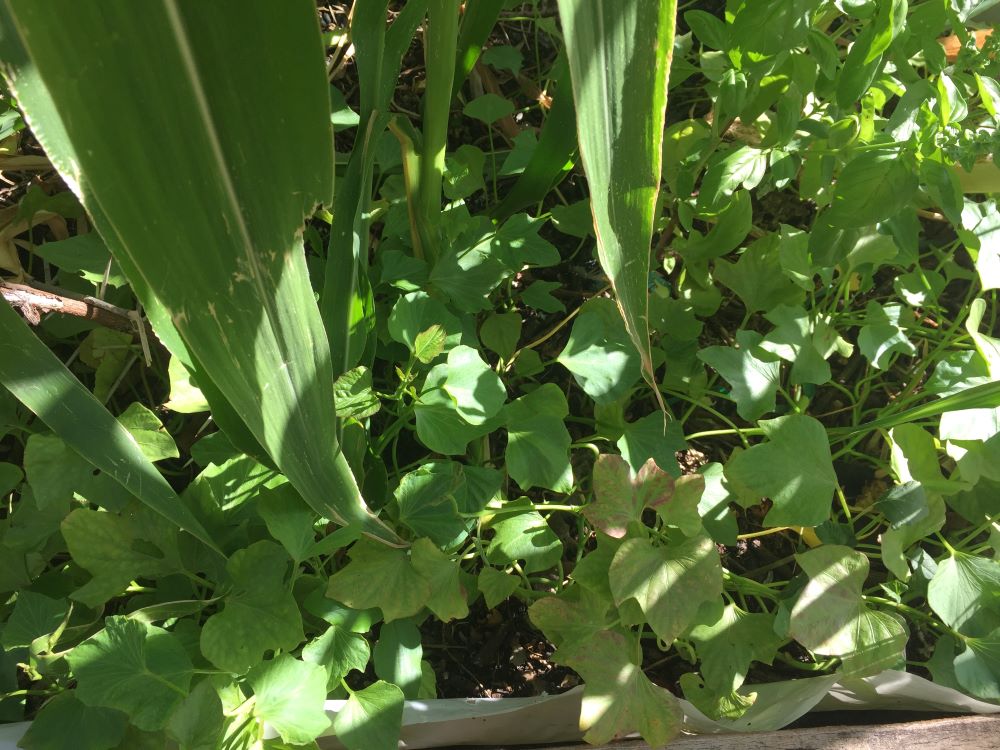 Sweet potato as a ground cover in the large plastic lined maize bed.
Sweet potato as a ground cover in the large plastic lined maize bed.Things don't grow so well in the ground here, and I believe its just too dry in the hot summer months, no matter how much I water with the watering can. I could install irrigation but since 'day zero' when our city nearly ran out of water, I think this is just environmental foolishness when there are so many ways of saving water.
Raised beds lined with plastic to retain moisture work much better for me. Even the root vegetables I’ve never managed to grow are flourishing. The sweet potatoes have done well in my containers and raised beds whereas I could never get them to go in the ground in our garden soil. I guess its just too dry here and all the watering in the world and adding massive amounts of organic material cannot create the kind of humidity you get in a water impermeable container. The slips did well in my hanging shelf garden. I just buried them in soil with some tips and a leaf or two showing, watered regularly and away they went. I’m very pleased because I’ve been struggling to grow sweet potato for years.
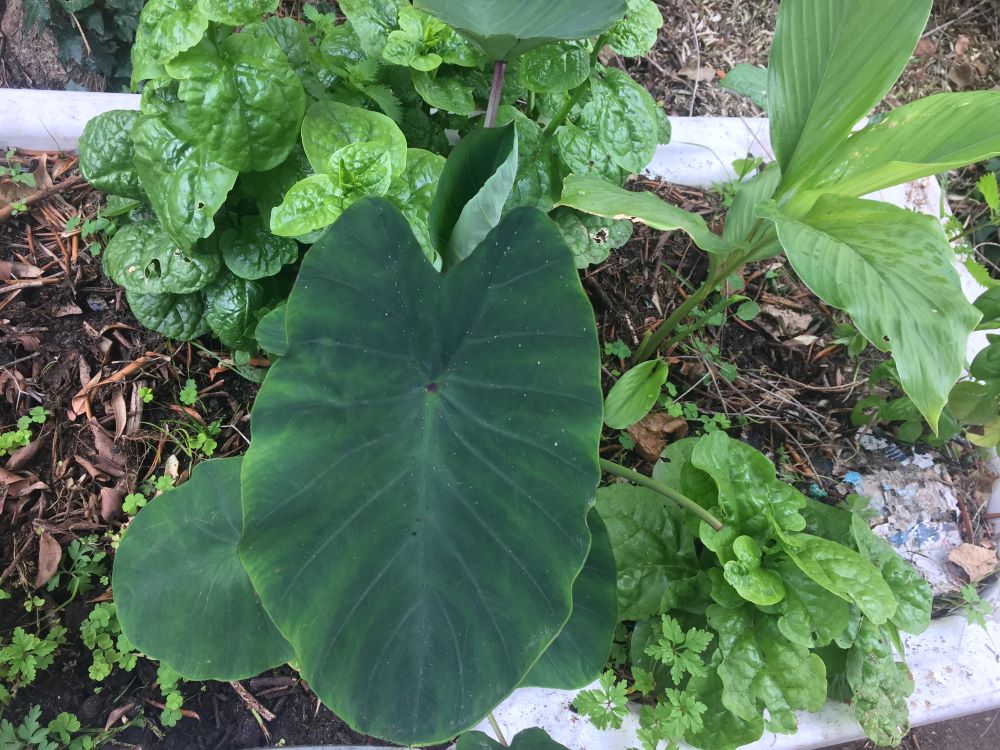 The bathtub 'swamp' with basil, taro, Malabar spinach and turmeric
The bathtub 'swamp' with basil, taro, Malabar spinach and turmericI have struggled with raising taro from tubers, had about ten fails to one success. A few years ago I had a huge plant in my grey water system, subdivided it and all the sets died. I now have one plant in the swamp garden (an old bath tub full of soil). Apparently tubers are not the best way, side shoots are better. I watched a video by an expert Hawaiian grower once who explained how to harvest and replant the stubs, explaining Hawaiian terms for all the parts of the plant and growing methods which was fascinating to an ex linguist like myself. I don’t really have a choice but to use tubers as I don’t have access to the plants this year.
The turmeric is coming. About 50% of the tubers have sent up leaves, some very slowly. The turmeric root pieces were very small. The garlic sprouted and then died. I think I planted close to fifty cloves. I wonder if they come again in the rainy season or if that is that. The potatoes in my bean bags were a complete fail. Many of them were rotten and I was just taking a chance. I often get potatoes growing in my garden beds in winter where there is no fertilization and little watering. I’ve heard you can grow potatoes from seed, and that it is not easy, but not that hard either. People use the tubers for vegetative reproduction to get consistency mainly. One of my potatoes did fruit last year, so I want to try this as an experiment. Apparently the seed can yield all kinds of variety, and one can get away from the dull white potatoes we have in our shops.
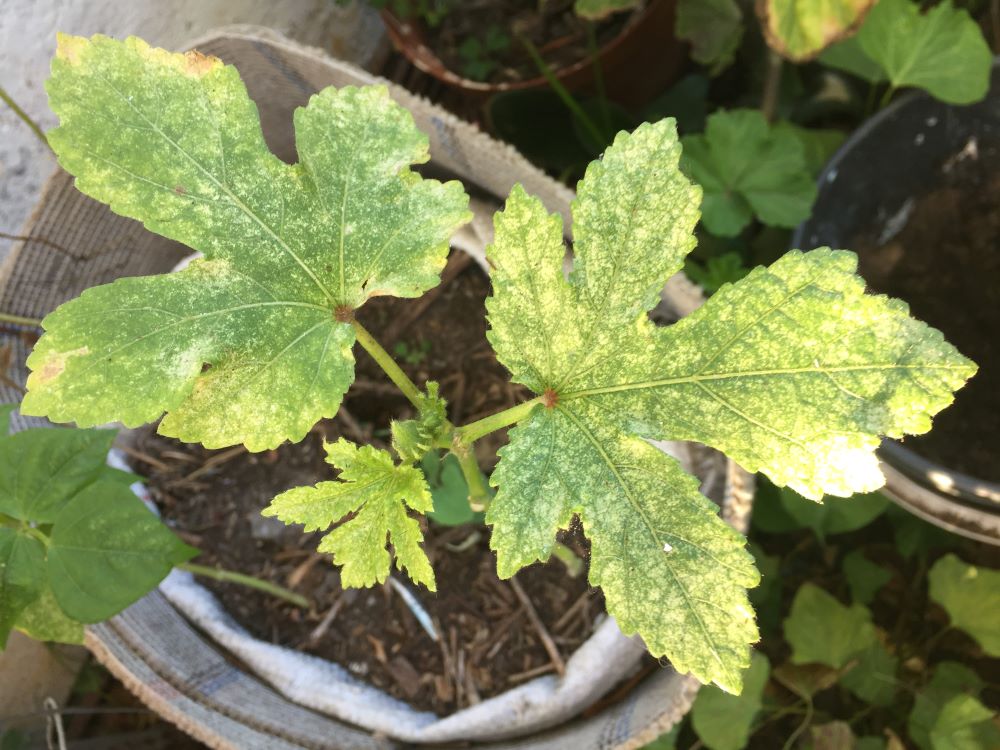 The last one standing. Spot the flower bud of this struggling okra bravely working on reproducing its genes.
The last one standing. Spot the flower bud of this struggling okra bravely working on reproducing its genes.The Ghanaian giant okra was a flop, literally. All seeds germinated and then keeled over. The only plant that survived got some kind of mozaic virus. It seems they are super vulnerable and can’t survive without chemical assistance so they can’t be part of my poison free setup. The lettuce, parsley and dill I sowed came up spottily. It was not their season and the lettuce and parsley died, and the dill lingered and then died too. I harvested the dill for a cucumber salad twice, but there wasn’t really enough to go round.
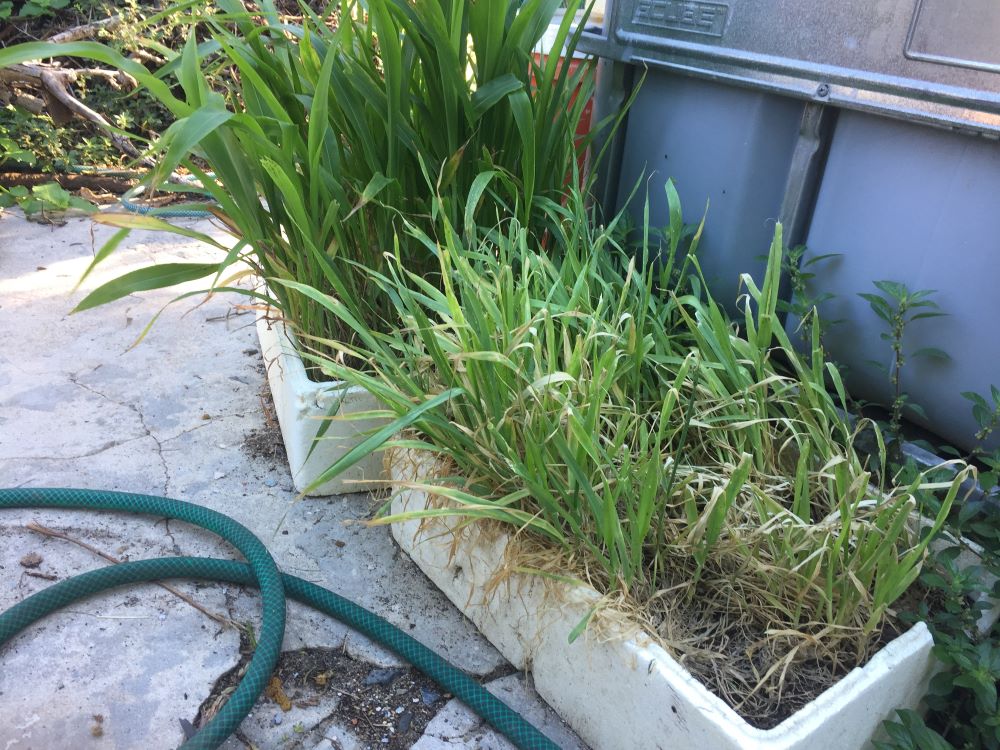 Something for everyone. well chewed barley and sorghum microgreens for our canine family.
Something for everyone. well chewed barley and sorghum microgreens for our canine family.Well that is the extent of my summer vegetable plantings. I'm now starting to save seed for next summer. I still think annuals are a huge effort for little return when it comes to fruiting plants like beans, maize, cucurbits, tomatoes, peppers and so on. My best fruiting plants are perennials such as native African berry bearing trees like Numnum, and other fruit trees like tamarillos and guavas. I can’t eat all the produce I get from them, and that with no effort post planting bar the harvesting. The greens, and the five or so vegetables I grow for leaf food are very yielding and easy, if you exclude the classics, lettuce and Cruciferae. Root crops are a real struggle and that includes onions, garlic, potatoes, sunchokes, taro, Chinese yam and sweet potato which have failed thus far, though things are looking brighter for Ipomea batatas.
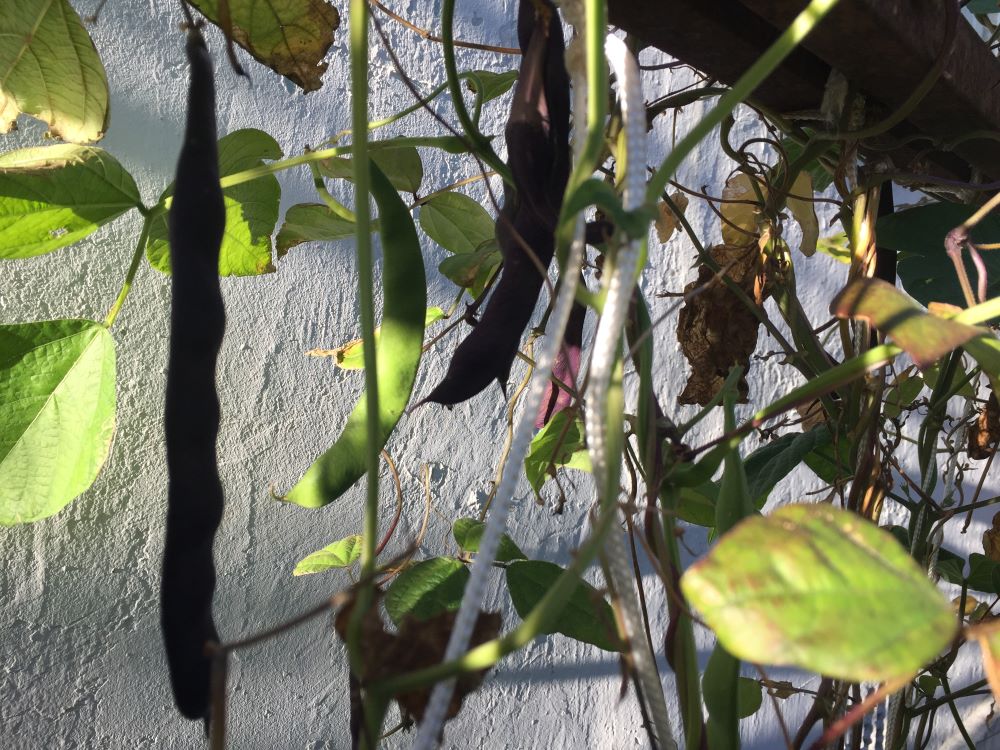 The dying bean vines are festooned with beans I'm ripening for next year's seed to increase the number of plants.
The dying bean vines are festooned with beans I'm ripening for next year's seed to increase the number of plants.All in all, my new surge at learning this craft has been very satisfying, but lots of hard work for very little yield. The results have been better than before but far from superb, and it is that progress in learning which was the main satisfaction. Self sufficiency I would now class as a dream, but some dreams do come true.. eventually.
I think the improvement was all due to two things: preventing desiccation in the hot dry weather, and adding nutrients to our naturally poor Cape soils. For the first time I used very large water holding containers and watered very regularly (daily or every second day). I added about half a cube of river silt I collected with extreme effort, and a lot of organics, from the large quantity of logs in the bottom of the beds, to dressings of compost, pigeon and human manure and other natural additives like rock dust, urine, worm castings, bone meal, kelp, ash and biochar.
Just a message to you, it isn't a walk in the park, so keep on trying even when you see people's wonderful harvests on facebook, and you are not getting there ! Don't give up, and go for some easy gratification too ! As I suggest in the article, native berries and leafy greens can be much much easier, even better for biodiversity and deliver superior levels of phytonutrients, and perhaps that is true wherever you live.
home page for links to articles on many major aspects of natural gardening
Restore Nature Newsletter
I've been writing for four years now and I would love to hear from you
Please let me know if you have any questions, comments or stories to share on gardening, permaculture, regenerative agriculture, food forests, natural gardening, do nothing gardening, observations about pests and diseases, foraging, dealing with and using weeds constructively, composting and going offgrid.
Your second block of text...
SEARCH
Order the Kindle E-book for the SPECIAL PRICE of only
Prices valid till 30.09.2023
Recent Articles
-
garden for life is a blog about saving the earth one garden at a time
Apr 18, 25 01:18 PM
The garden for life blog has short articles on gardening for biodiversity with native plants and regenerating soil for climate amelioration and nutritious food -
Cape Flats Sand Fynbos, Cape Town's most endangered native vegetation!
Apr 18, 25 10:36 AM
Cape Flats Sand Fynbos, a vegetation type found in the super diverse Cape Fynbos region is threatened by Cape Town's urban development and invasive alien plants -
Geography Research Task
Jan 31, 25 11:37 PM
To whom it may concern My name is Tanyaradzwa Madziwa and I am a matric student at Springfield Convent School. As part of our geography syllabus for this
"How to start a profitable worm business on a shoestring budget
Order a printed copy from "Amazon" at the SPECIAL PRICE of only
or a digital version from the "Kindle" store at the SPECIAL PRICE of only
Prices valid till 30.09.2023







